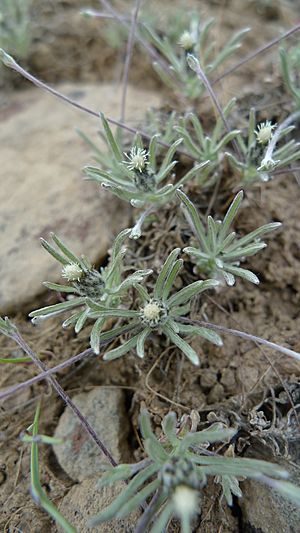Whip pussytoes facts for kids
Quick facts for kids Whip pussytoes |
|
|---|---|
 |
|
| Antennaria flagellaris on Badger Mountain, Douglas County Washington | |
| Scientific classification | |
| Genus: |
Antennaria
|
| Species: |
flagellaris
|
| Synonyms | |
|
|
Antennaria flagellaris, also known as whip pussytoes or stoloniferous pussytoes, is a small flowering plant found in North America. It belongs to the daisy family, which is a very large group of plants! This tiny plant often grows in dry, open areas, especially where sagebrush is common.
Contents
Where Whip Pussytoes Grows
This plant is mostly found in the western parts of the United States, like Washington, Oregon, Idaho, and northern Nevada. You can also spot it in some areas of northeastern California, Wyoming, and the Black Hills of South Dakota. It even grows in the Canadian Province of British Columbia.
Whip pussytoes likes to live in places with scrub, which are dry lands covered with shrubs. It is a common plant in the Great Basin and Columbia Plateau regions.
What Whip Pussytoes Looks Like
Whip pussytoes is a very small plant, usually growing only about 2 centimeters (less than an inch) tall. It forms a thin patch on the ground.
Spreading Stems
This plant grows from a slender base called a caudex. It spreads out using thin, wiry stems called stolons. These stolons look a bit like cobwebs and help the plant cover more ground.
Leaves and Flowers
The leaves of the whip pussytoes are grayish and feel woolly. They are usually one to two centimeters long and shaped like a spear.
The plant produces tiny flower heads, each less than a centimeter wide. These flower heads are not just one flower but a cluster of many small flowers that look like a single bloom.
How Whip Pussytoes Reproduces
Antennaria flagellaris is a dioecious species. This means that individual plants are either male or female.
Male and Female Plants
- Male plants produce only staminate flowers. These flowers have parts that make pollen.
- Female plants produce only pistillate flowers. These flowers have parts that can develop into seeds.
Seeds and Fruit
After the female flowers are pollinated, they produce a bumpy fruit called an achene. This achene can be up to a centimeter long. It has a long, soft, feathery part called a pappus attached to it. The pappus helps the seeds float away on the wind, spreading the plant to new places.
See also
 In Spanish: Antennaria flagellaris para niños
In Spanish: Antennaria flagellaris para niños

